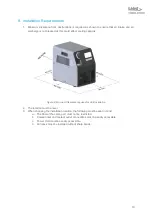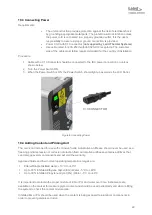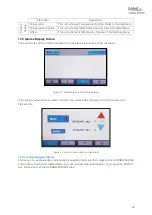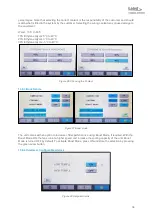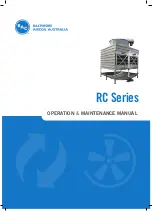
20
10. Installation Procedure
10.1 Connect Hoses
NOTE
Risk of damage by using improper or faulty coolant hoses
This may lead to damage to persons, damage to property, or corrosion damage.
▪
When choosing coolant hoses pay attention to burst pressure and compatibility with coolant.
▪
Only use coolant hoses without any signs of damage.
▪
If water is being used as coolant, ensure that non-transparent hoses are used to prevent algae
growth in the water. Otherwise, appropriate additives must be used.
NOTE
When connecting the coolant hoses pay attention to flow direction. Follow the documentation
released by the manufacturer of the unit to be cooled.
Transparent coolant hoses increase algae growth and biofouling of the components in the unit, and
this reduces the performance of the unit. Thus, only use non-transparent coolant hoses.
The coolant hoses are connected to the unit by means of quick disconnect couplings from Colder
Products. Coolant inlet and coolant outlet are labeled with respective symbols.
Figure 7 Connecting Hoses
Requirements
▪
Unit prepared for maintenance. Refer to
Preparing the Unit for Maintenance
▪
Hoses
Procedure
1.
Remove the protection caps from the coolant inlet and coolant outlet connections of the unit.
2.
Connect an appropriate coolant hose to the coolant inlet and coolant outlet respectively.
3.
Connect the coolant hoses to the corresponding connections of the unit to be cooled.
The coolant hoses are now connected to the unit.
O TL T
I L T
Содержание Nextreme NRC400
Страница 1: ...Nextreme Thermoelectric Chiller NRC400 Specification and User Manual ...
Страница 13: ...13 6 Component Locations Figure 2 Isometric Views of Unit Figure 3 Front View Figure 4 Rear View ...
Страница 24: ...24 Plumbing Refrigeration Diagram Figure 10 Plumbing and Refrigeration Diagram ...
Страница 27: ...27 11 2 Pump Performance Figure 14 Pump Performance with Cooling Fluids Water 30 EG W NRC 400 T0 00 PC2 ...
Страница 28: ...28 12 Chiller Dimensions Figure 15 NRC400 Chiller Overall Dimensions ...














